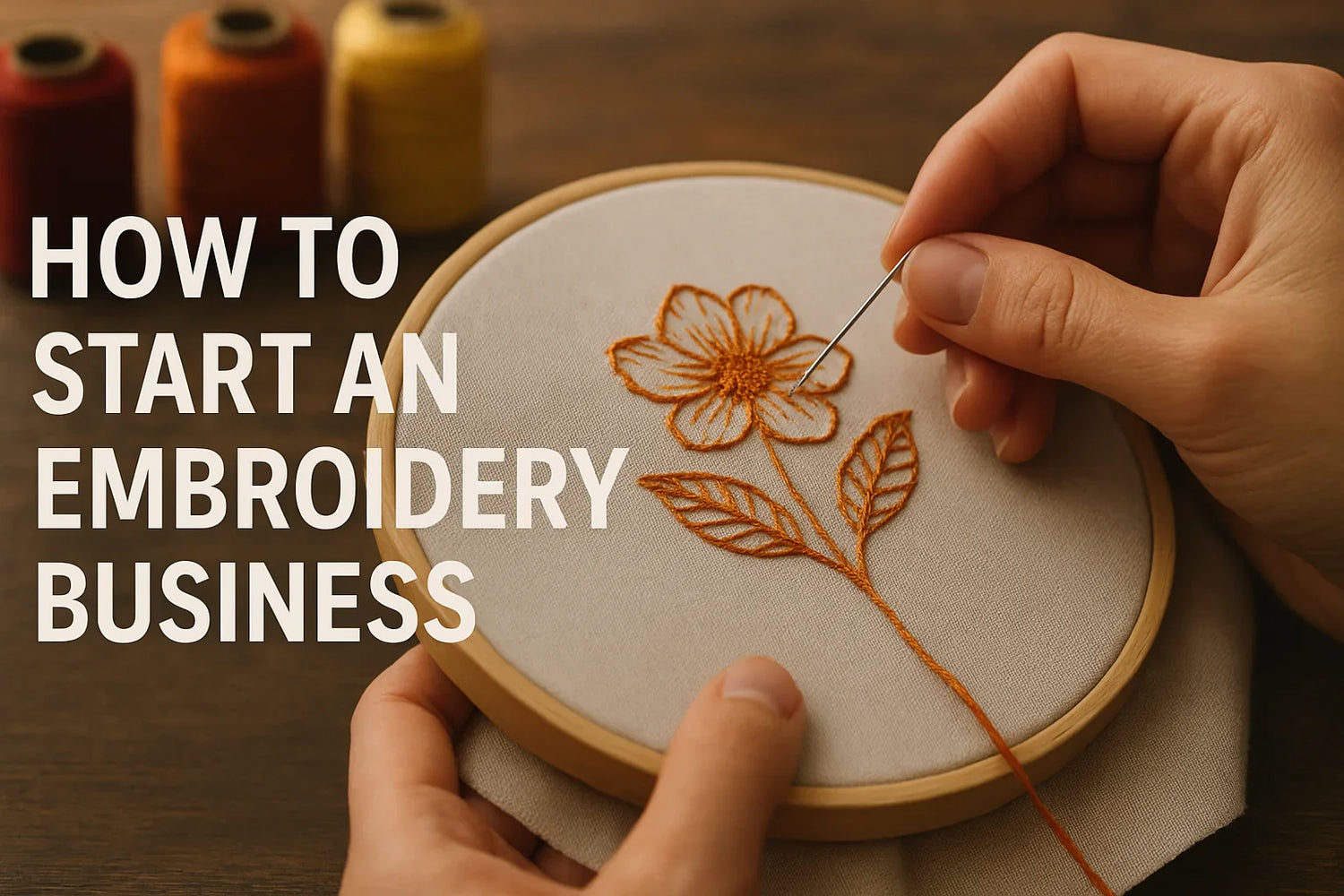Introduction
Starting an embroidery business is one of the most exciting ways to turn your creativity into a profitable venture. From custom t-shirts to personalized hats and corporate uniforms, embroidery has become a go-to solution for people and businesses looking for unique, high-quality apparel.
If you’re wondering how to start an embroidery business, you’re in the right place. This guide is designed for beginners, hobbyists, or anyone looking to scale their small embroidery venture. You’ll learn everything from selecting your niche to setting up your workspace, acquiring the right equipment, and marketing your services effectively.
By following these step-by-step strategies, you can create a sustainable embroidery business, attract loyal customers, and even explore on-demand embroidery and print-on-demand services. Ready to turn your stitching skills into a full-fledged business? Let’s dive in!
Key Takeaways
- Embroidery is a low-cost, high-demand business that’s perfect for creative entrepreneurs looking to start small and scale smart.
- Choosing a niche—like t-shirt embroidery, corporate branding, or personalized gifts—helps you stand out and attract loyal clients.
- A home-based setup is enough to begin, with a single-head machine, basic supplies, and a small workspace.
- Offering embroidery print on demand and combining it with DTF/DTG services opens up recurring revenue and bulk order opportunities.
Why Start an Embroidery Business?
You might be wondering why starting an embroidery business is such a smart move. The truth is, embroidery isn’t just a craft — it’s a growing market with plenty of opportunities for both beginners and seasoned entrepreneurs. Here’s why:
1. Growing Demand for Customization
From t-shirt embroidery to personalized hats, bags, and jackets, custom embroidery is everywhere. Businesses need it for branding—think uniforms, promotional gear, and team apparel. This rising demand makes starting an embroidery business a timely and profitable idea.
2. Low Startup Costs
Unlike other fashion ventures, embroidery doesn’t require a huge inventory or expensive materials. A single-head machine, basic threads, and blank apparel are enough to take your first orders and start earning.
3. Flexible Setup
You can run your embroidery business from a home studio, sell through online marketplaces, or open a storefront when you're ready to scale. This flexibility lets you grow at your own pace while keeping overhead low.
4. Creative Freedom
Embroidery lets you design what you love—whether it’s streetwear, personalized gifts, or corporate branding. You control the styles, colors, and niche, making it a perfect outlet for creative entrepreneurs.
5. Recurring Revenue Potential
Once you land corporate clients or offer embroidery print on demand, you unlock steady income through bulk orders, subscriptions, and repeat business. It’s a creative hobby that can evolve into a reliable revenue stream.
Step-by-Step Guide to Launching Your Embroidery Business
Starting an embroidery business may feel overwhelming at first, but breaking it down into clear steps makes it manageable. Here’s a practical roadmap you can follow to turn your passion into a profitable venture.
Step 1: Define Your Niche and Target Market
Before investing in machines or materials, it’s essential to identify your ideal customers. Your niche will guide your product offerings, pricing, and marketing strategies. Popular niches include:
-
Personalized Gifts: Weddings, baby showers, anniversaries, and birthdays are perfect opportunities for custom embroidery. Personalized items such as t-shirts, hoodies, tote bags, and caps are always in demand.
-
Corporate Branding: Many businesses need uniforms, hats, jackets, and promotional merchandise embroidered with their logos. Corporate clients can offer recurring bulk orders, which helps maintain steady revenue.
-
Fashion & Streetwear: Embroidered apparel is a growing trend in local and online fashion. Limited-edition designs or collaborations with online brands can create high-value sales.
- Local vs. Online Audience: Decide if you want to focus on local walk-in customers, online shoppers, or a combination. Local markets can provide immediate sales, while online marketplaces allow you to scale and reach global audiences.
Tip: Research competitors and check trending embroidery products on platforms like Etsy or Pinterest. Validating demand before investing will save time and money.
Step 2: Choose the Right Embroidery Equipment
Having the right tools is crucial for producing quality embroidery and scaling your business effectively.
Machine Types:
-
Single-head computerized machines: Great for beginners and small batch orders.
-
Multi-head machines: Ideal for scaling and handling bulk orders efficiently.
- Manual machines: Good for artistic or specialty projects, but slower for commercial production
-
Essential Accessories: Hoops, stabilizers, embroidery threads, needles, scissors, backing materials, and thread organizers. These accessories improve efficiency and ensure professional-quality results.
-
Budget vs. Professional-Grade: Start with an affordable setup if you’re new. As your business grows, invest in high-end machines and additional tools to increase capacity and efficiency.
Comparison Table: Beginner vs Scaling Setup
|
Feature |
Beginner Setup |
Scaling Setup |
|
Machine |
Single-head computerized |
Multi-head computerized |
|
Threads |
Basic color set |
Complete premium collection |
|
Workspace |
Home studio |
Commercial studio |
|
Orders Capacity |
Small batch / custom |
Bulk orders & corporate clients |
Pro Tip: Look for machines that support both embroidery and on-demand embroidery services, so you can offer a broader range of products like t-shirt embroidery and custom merchandise.
Step 3: Set Up Your Workspace
Your workspace directly impacts productivity and quality.
-
Lighting and Ventilation: Proper lighting helps reduce mistakes and eye strain, while good ventilation ensures a comfortable work environment.
-
Workflow Organization: Arrange your machines, threads, and tools for smooth order processing — from artwork approval to finished product.
- Storage Solutions: Use thread racks, storage bins, and shelving to keep materials organized. Label everything to avoid confusion, especially when handling multiple orders.
Example: A home studio with an organized layout can handle multiple orders efficiently, while a commercial space with separate production, packing, and shipping zones is ideal for scaling.
Step 4: Learn the Craft or Hire Skilled Help
Even with the best machines, your skill or the skill of your team determines the quality of your embroidery business.
-
Training & Courses: Invest time in online courses, tutorials, or certifications that teach embroidery techniques and digitizing software.
-
Practice Makes Perfect: Start by creating sample designs before taking client orders. Testing different fabrics, threads, and stitches will improve your final output.
-
Outsourcing Options: For complex digitizing or high-volume orders, consider hiring freelancers or subcontracting production.
- Quality Control: Develop a checklist for every order to ensure consistent results — this builds trust with clients and encourages repeat business.
Step 5: Create a Business Plan That Works
A clear business plan keeps you focused and helps you grow sustainably.
-
Startup Costs: Estimate costs for machines, threads, blanks, software, website setup, and marketing campaigns.
-
Pricing Strategy: Calculate costs per stitch, per item, or setup fee. Don’t forget to account for overheads and profit margins.
-
Branding & Positioning: Choose a memorable business name, create a professional logo, and define your unique selling proposition.
- Revenue Goals & Growth Plan: Set realistic short-term and long-term targets. Plan when to invest in upgrades or expand into Embroidery print on demand services.
Step 6: Build a Winning Online Presence
An online presence is crucial for growth and visibility.
-
Professional Website: Showcase your portfolio, services, pricing, and easy contact forms.
-
SEO Optimization: Use keywords like “starting an embroidery business,” “t-shirt embroidery,” and “best embroidery print on demand” in page titles, headers, and descriptions.
-
Social Media Marketing: Share behind-the-scenes content, customer stories, and before/after transformations to engage potential clients.
- Testimonials & Reviews: Positive feedback builds credibility and helps attract high-value clients.
Step 7: Offer Customization and Print-On-Demand Services
Expanding into on-demand embroidery increases revenue and attracts a wider audience:
- Combine embroidery with custom dtf transfers/DTG printing to provide complete custom apparel solutions.
- Target bulk orders, fashion brands, or corporate clients for recurring income.
- Use mockup tools and automated order management to streamline your workflow.
- Offer subscription services or retainers to secure long-term clients.
Smart Marketing Strategies for Embroidery Success
Launching your embroidery business is just the first step. To grow and attract clients, you need a solid marketing strategy. Here are proven ways to promote your embroidery business and boost sales:
1. Partner with Local Businesses and Organizations
Reach out to schools, sports teams, corporates, and local clubs. They often need uniforms, branded merchandise, or custom gifts — a perfect match for t-shirt embroidery and other on-demand embroidery services.
2. Collaborate with Influencers and Affiliates
Influencers in fashion, lifestyle, or small business niches can help showcase your embroidery work. Affiliate partnerships let others earn a commission for bringing you new customers — expanding your reach without upfront ad costs.
3. Email Marketing and Lead Magnets
Build a list of potential customers by offering downloadable resources like a “Custom Embroidery Ideas Guide” or “Starter Checklist for On-Demand Embroidery.” Send newsletters with promotions, tips, and new design launches to keep your audience engaged.
4. Optimize Online Marketplaces
Platforms like Etsy, Pinterest, and even Quora are great for promoting your embroidery business. Use keywords like starting an embroidery business, embroidery print on demand, and best embroidery print on demand to make your listings discoverable.
5. Seasonal and Event-Based Campaigns
Plan marketing campaigns around holidays, wedding seasons, graduation, or corporate events. Offering themed products or limited-time discounts can generate quick orders and boost your revenue.
6. Leverage Social Media Content
Instagram, Facebook, and TikTok are excellent platforms to showcase your embroidery designs. Post short clips of your process, time-lapse videos of t-shirt embroidery, and customer testimonials. Visual content helps clients see the quality and craftsmanship of your work.
Common Mistakes to Avoid When Starting an Embroidery Business
Even the most talented embroidery enthusiasts can stumble when starting a business. Knowing common pitfalls in advance can save time, money, and frustration. Here are some mistakes to avoid:
1. Underpricing Your Work
Many beginners undervalue their time and materials. Make sure to calculate costs accurately — including threads, blanks, labor, and overhead — to ensure profitability. Offering discounts is fine, but never at the expense of your bottom line.
2. Ignoring Quality Control
A single mistake on an order can damage your reputation. Always check stitches, color accuracy, and packaging before sending out items. High-quality work leads to repeat customers and positive reviews.
3. Overcomplicating Your Niche
Trying to serve everyone can dilute your brand. Focus on a few core products or niches first, like t-shirt embroidery for corporate clients or personalized gifts. You can expand later once your business grows.
4. Poor Customer Communication
Prompt and clear communication is key. Respond to inquiries quickly, provide realistic timelines, and update clients if there are any delays. Strong communication builds trust and loyalty.
5. Neglecting Online Presence and Reviews
A website, social media, and online reviews are crucial for credibility. Many clients search online for “embroidery business near me” or “best embroidery print on demand,” so missing these opportunities can cost potential sales.
Faq Section
Q1: How much does it cost to start an embroidery business?
Ans: You can start an embroidery business for as little as $500 to $1,000 with a basic home setup. A professional studio with multi-head machines and digitizing software may cost $3,000 to $5,000 or more, depending on scale and equipment.
Q2: Is an embroidery business profitable?
Ans: Yes, embroidery can be very profitable. With low startup costs and high demand, many businesses earn 30–60% profit margins, especially through bulk orders and print-on-demand services.
Q3: Can I run an embroidery business from home?
Ans: Yes, you can start from a home studio with proper lighting, ventilation, and organized storage. Home-based setups are flexible, cost-effective, and perfect for testing your niche.
Q4: How long does it take to complete an embroidery order?
Ans: Small orders like custom t-shirt embroidery typically take 1–3 days. Bulk or complex designs may take longer. Efficient workflow and automation help speed up production.
Conclusion
Starting an embroidery business is a great way to turn creativity into profit. Whether you’re making personalized t-shirts, corporate uniforms, or offering on-demand embroidery, there’s strong demand and plenty of opportunities to grow.
Focus on learning the craft, setting up your workspace, and building a professional online presence. Over time, you can expand into customization and Embroidery print on demand services to attract more clients and generate recurring revenue.
Success comes from quality work, understanding your customers, and smart marketing. Ready to get started? Explore Aesthetic Bk’s embroidery services or download our free embroidery business setup checklist to plan your first steps.



Leave a comment
This site is protected by hCaptcha and the hCaptcha Privacy Policy and Terms of Service apply.